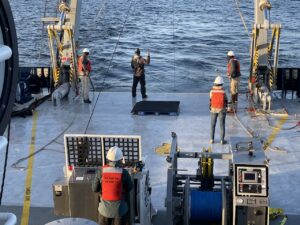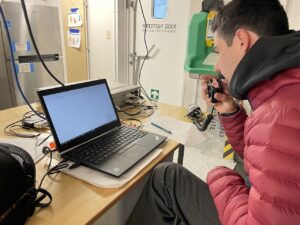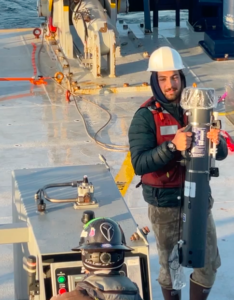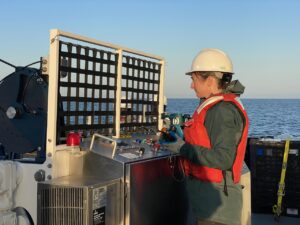Monday, June 05, 2023 – Offshore North Pacific Coast (Latitude: 39.03.103 N; Longitude: 123.53.768 W)
The Ties That Bind Us

The Ligands Team works closely with the Trace Metal Team in their secluded lab location. Laura Sofen (Bigelow Laboratory for Ocean Sciences), Ben Frieberger, and Max Fenton from Scripps Institute of Oceanography, and Peter Bright (Oregon State University) are investigating the concentrations of ligands and trace metals during the upwelling cycle. Trace metals dissolve when they react with ligands. This process assists in the iron cycle by providing phytoplankton with iron in a dissolved form that can be used for growth and development. Think of ligands as a catalyst to help the microbes take in all of their nutritional requirements.


Ligand molecules can also combine with other trace metals such as Copper, Nickel, Cobalt, Lead, Aluminum, Magnesium, Zinc, and Cadmium. Peter (OSU) is analyzing seawater throughout the upwelling plume to identify the various types of ligand compounds being formed at difference stages in the upwelling cycle. Laura (Bigelow) is measuring the concentrations of trace metals (e.g., Iron, Manganese, Nickel, Copper, Zinc, and Cobalt) found in the individual cells of phytoplankton, primarily diatoms. She will also measure the responses of the phytoplankton as these trace metals become less available toward the end of the upwelling cycle.

While Laura and Peter monitor changes in the biomass (plankton) and trace metal micronutrients, Max is using seawater samples from the upwelling plume to test a new sensor being developed at Scripps.
According to Max, “The sensor provides a new method to measure the concentrations of iron in the ocean.” Some of the preliminary data he has seen during the research cruise looks quite promising for the sensor’s accuracy. The research conducted by the Trace Metal and Ligand Teams provides yet another example that science and technology are always changing.
